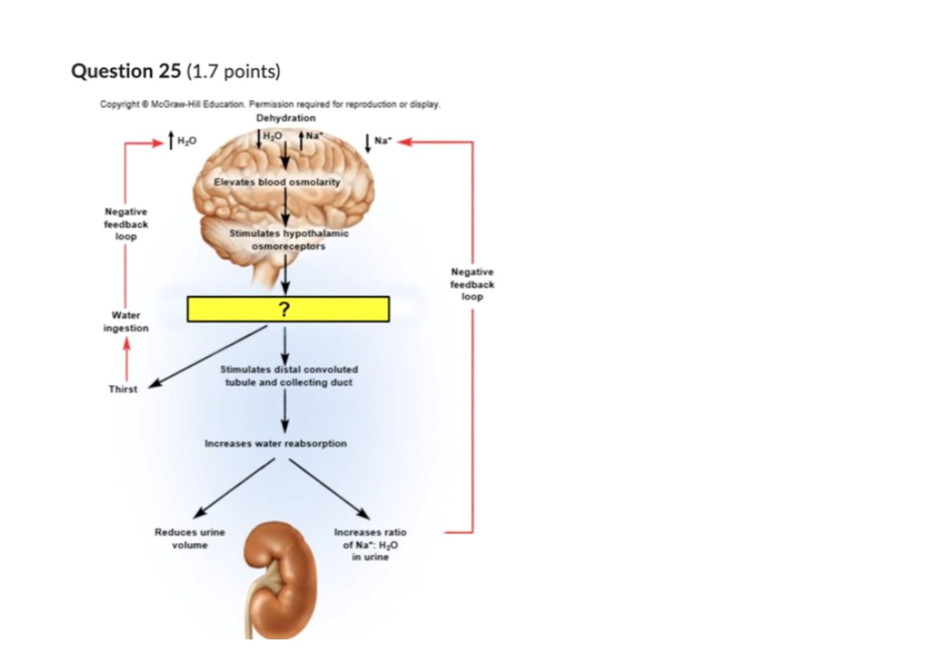As shown in this diagram, increased blood osmolarity stimulates hypothalamic osmoreceptors. What happens next? (What goes in the yellow box?)

Posterior pituitary releases ADH
Adrenal medulla releases aldosterone
Kidneys release erythropoietin
Anterior pituitary releases oxytocin
Adrenal cortex releases norepinephrine
The Correct Answer is A
A. Posterior pituitary releases ADH: Dehydration increases blood osmolarity. This is sensed by hypothalamic osmoreceptors. In response, the hypothalamus signals the posterior pituitary to release antidiuretic hormone (ADH). ADH then acts on the distal convoluted tubules and collecting ducts of the kidney to promote water reabsorption, thereby concentrating the urine and reducing blood osmolarity.
B. Adrenal medulla releases aldosterone: Aldosterone is released from the adrenal cortex, not medulla, and is more responsive to low sodium or high potassium, not directly to osmolarity.
C. Kidneys release erythropoietin: Erythropoietin is released in response to hypoxia, not dehydration or osmolarity.
D. Anterior pituitary releases oxytocin: Oxytocin is released by the posterior pituitary, and it is not involved in osmolarity or water balance.
E. Adrenal cortex releases norepinephrine: Norepinephrine is released by the adrenal medulla, and is involved in fight-or-flight, not osmolarity regulation.
Nursing Test Bank
Naxlex Comprehensive Predictor Exams
Related Questions
Correct Answer is E
Explanation
A. 2 ATP: This is the ATP yield from glycolysis (net gain), not fatty acid oxidation.
B. 18 ATP: Too low for a 16-carbon fatty acid-this number is far below the actual ATP yield from fatty acid metabolism.
C. 36 ATP: This is the approximate ATP yield from glucose oxidation, not a 16-carbon fatty acid.
D. 38 ATP: Also close to glucose metabolism; still too low.
E. 129 ATP: Beta-oxidation of a 16-carbon fatty acid (e.g., palmitic acid) generates 129 ATP molecules, making it far more energy-dense than glucose.
Correct Answer is B
Explanation
A. It regulates the rate of filtrate formation: The juxtaglomerular complex (JGC) helps control glomerular filtration rate (GFR) by monitoring filtrate content and flow.
B. Its macula densa cells produce aldosterone: Macula densa cells sense sodium concentration but do not produce aldosterone. Aldosterone is secreted by the adrenal cortex.
C. Its granular cells produce renin: Granular (juxtaglomerular) cells release renin in response to low blood pressure or sodium.
D. It helps control systemic blood pressure: Through renin release and the RAAS system, the JGC helps regulate blood pressure.
Whether you are a student looking to ace your exams or a practicing nurse seeking to enhance your expertise , our nursing education contents will empower you with the confidence and competence to make a difference in the lives of patients and become a respected leader in the healthcare field.
Visit Naxlex, invest in your future and unlock endless possibilities with our unparalleled nursing education contents today
Report Wrong Answer on the Current Question
Do you disagree with the answer? If yes, what is your expected answer? Explain.
Kindly be descriptive with the issue you are facing.
